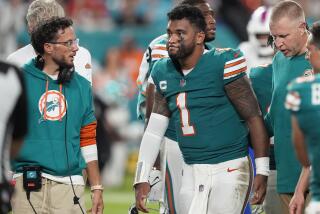Unknown Penalties of Football Concussions
- Share via
If San Francisco 49er quarterback Steve Young is pondering his future in football after suffering the latest in a series of concussions Sunday, he won’t get much solid advice from science.
There are few medical studies to show the effects of having sustained several concussions. And no studies have been done to show if there is cumulative damage from numerous concussions in football.
“That is something that has never been totally defined,” says Dr. Stephen Levy, medical director of neurological services and rehabilitation at Centinela Hospital Medical Center, Inglewood.
A few studies have been done on boxers and on non-athletes, such as motorcycle riders. But, says Dr. Jim Kelly, a Chicago neurologist and sports medicine expert: “The data is still out on repeated concussions in football.”
Young suffered a concussion during the first half of the Dallas game Sunday. He had absorbed several hard knocks and took himself out of the game with the 49ers leading 10-0. (San Francisco lost in overtime.)
In a statement released after the game, Young said: “I tried to come back in. But it was clear [that] in trying to call the plays I just wasn’t focused. I feel much better now; my memory is coming back. I, along with the doctors, will monitor my progress as the week goes on.”
The injury was Young’s second concussion in three weeks; the earlier trauma came in a game three weeks ago in Houston. The latest injury unsettled Young’s teammates, some of whom speculated about whether it was in his best interest to keep playing. Young, 35, has sustained five concussions during his 10 years with the 49ers.
(In wire reports Thursday, Young, sidelined for all or part of seven games due to injury this season, said he anticipated missing only this week. “I feel great,” Young said. “I talked to the neurologist, and he saw how good I felt. I think he wanted to say, ‘Go ahead and play’ but just felt because of two in 14 days” it would be wise to take time off.)
Elusive by its definition, a concussion is described more by its symptoms than by any tangible impact on the brain. It occurs when the brain is jarred or shaken.
“It’s a blow to the head,” Levy says. “It’s not accompanied by any brain lesion or bleeding or distortion. If you looked at the brain, you wouldn’t see anything wrong. The patient, by all measurements, appears normal.”
The patient doesn’t act normal, however. Concussions usually trigger five or six prominent symptoms, depending on the severity of the blow, including: loss of consciousness (ranging from seconds to 15 minutes); amnesia of the events just prior to the blow; vomiting; headaches; giddiness or unsteady gait; and reduced mental performance.
“Sometimes a guy takes a hit and it’s only when you are around the person for a few minutes you begin to see that the person isn’t acting normal,” Levy says.
Former Rams quarterback Chris Miller, who suffered five concussions in a 15-month span, once stunned a friend when he suddenly announced that he had to rush to catch a plane because “we’re playing Denver tomorrow.” In fact, Miller, who had had a concussion two weeks earlier, wasn’t due to play again for another week.
Athletic trainers often assess concussions based on three descriptions of severity, says Howard Rappaport, a former National Football League trainer who is now with the Professional Sports and Orthopedic Care center in Pasadena.
A Grade One concussion usually does not involve a loss of consciousness, Grade Two can cause a momentary lapse of consciousness, and Grade Three generally features significant memory loss and disorientation.
Players usually remain out of action for at least two weeks after a Grade Two blow and four weeks or more after a Grade Three, Rappaport says. But there are few guidelines on what to do after back-to-back concussions.
One landmark British study showed that the brains of boxers studied in autopsies bore signs of tiny hemorrhages, Levy says.
Some NFL teams are conducting studies to see if there are “neuropsychological declines” in players who have had concussions, Kelly says. (Previous NFL reports have estimated there is one concussion every 3 1/2 games.)
“These are sensitive tests that assess for quickness of speech, accuracy of processing information, attention skills, concentration and memory.”
Young may instead look to what others in his situation have done. Miller retired last year and New York Jets receiver Al Toon also quit after suffering persistent problems related to repeated concussions.
“Those two guys helped to bring this to light,” Rappaport says. “Before them, you didn’t hear much about this.”
More to Read
Go beyond the scoreboard
Get the latest on L.A.'s teams in the daily Sports Report newsletter.
You may occasionally receive promotional content from the Los Angeles Times.










